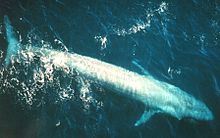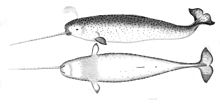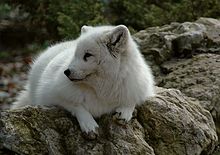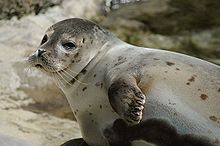List of mammals of Iceland
This article has multiple issues. Please help improve it or discuss these issues on the talk page. (Learn how and when to remove these messages)
|
This is a list of the mammal species recorded in Iceland. There are twenty-eight mammal species in Iceland, of which four are endangered and four are vulnerable.[1]
The following tags are used to highlight each species' conservation status as assessed by the International Union for Conservation of Nature:
| EX | Extinct | No reasonable doubt that the last individual has died. |
| EW | Extinct in the wild | Known only to survive in captivity or as a naturalized populations well outside its previous range. |
| CR | Critically endangered | The species is in imminent risk of extinction in the wild. |
| EN | Endangered | The species is facing an extremely high risk of extinction in the wild. |
| VU | Vulnerable | The species is facing a high risk of extinction in the wild. |
| NT | Near threatened | The species does not meet any of the criteria that would categorise it as risking extinction but it is likely to do so in the future. |
| LC | Least concern | There are no current identifiable risks to the species. |
| DD | Data deficient | There is inadequate information to make an assessment of the risks to this species. |
Order: Rodentia (rodents)
Rodents make up the largest order of mammals, with over 40% of mammalian species. They have two incisors in the upper and lower jaw which grow continually and must be kept short by gnawing. Most rodents are small though the capybara can weigh up to 45 kg (100 lb).
- Suborder: Myomorpha
- Family: Muridae (mice, rats, gerbils, etc.)
- Subfamily: Murinae
- Genus: Apodemus
- Wood mouse, A. sylvaticus LC
- Genus: Mus
- House mouse, M. musculus LC introduced
- Genus: Rattus
- Genus: Apodemus
- Subfamily: Murinae
- Family: Muridae (mice, rats, gerbils, etc.)
Order: Lagomorpha (rabbits, hares and pikas)
The lagomorphs comprise two families, Leporidae (hares and rabbits), and Ochotonidae (pikas). Though they can resemble rodents, and were classified as a superfamily in that order until the early 20th century, they have since been considered a separate order. They differ from rodents in a number of physical characteristics, such as having four incisors in the upper jaw rather than two.
- Family: Leporidae (rabbits, hares)
- Genus: Oryctolagus
- European rabbit, O. cuniculus EN introduced
- Genus: Oryctolagus
Order: Cetacea (whales)



The order Cetacea includes whales, dolphins and porpoises. They are the mammals most fully adapted to aquatic life with a spindle-shaped nearly hairless body, protected by a thick layer of blubber, and forelimbs and tail modified to provide propulsion underwater.
- Suborder: Mysticeti
- Family: Balaenidae
- Genus: Balaena
- Bowhead whale, Balaena mysticetus CR
- Genus: Eubalaena
- North Atlantic right whale, Eubalaena glacialis CR
- Genus: Balaena
- Family: Balaenopteridae
- Subfamily: Balaenopterinae
- Genus: Balaenoptera
- Minke whale, Balaenoptera acutorostrata LC
- Sei whale, Balaenoptera borealis EN
- Blue whale, Balaenoptera musculus EN
- Fin whale, Balaenoptera physalus NT
- Genus: Balaenoptera
- Subfamily: Megapterinae
- Genus: Megaptera
- Humpback whale, Megaptera novaeangliae LC
- Genus: Megaptera
- Subfamily: Balaenopterinae
- Family: Eschrichtiidae
- Genus: Eschrichtius
- Gray whale, Eschrichtius robustus extirpated from Iceland
- Genus: Eschrichtius
- Family: Balaenidae
- Suborder: Odontoceti
- Superfamily: Platanistoidea
- Family: Monodontidae
- Genus: Monodon
- Narwhal, Monodon monoceros LC
- Genus: Delphinapterus
- Beluga, Delphinapterus leucas LC
- Genus: Monodon
- Family: Phocoenidae
- Genus: Phocoena
- Harbour porpoise, Phocoena phocoena VU
- Genus: Phocoena
- Family: Ziphidae
- Subfamily: Hyperoodontinae
- Genus: Hyperoodon
- Northern bottlenose whale, Hyperoodon ampullatus DD
- Genus: Mesoplodon
- Sowerby's beaked whale, Mesoplodon bidens DD
- Genus: Hyperoodon
- Subfamily: Hyperoodontinae
- Family: Delphinidae (marine dolphins)
- Genus: Lagenorhynchus
- Atlantic white-sided dolphin, Lagenorhynchus acutus LC
- White-beaked dolphin, Lagenorhynchus albirostris LC
- Genus: Delphinus
- Short-beaked common dolphin, Delphinus delphis DD vagrant
- Genus: Stenella
- Striped dolphin, Stenella coeruleoalba DD
- Genus: Tursiops
- Common bottlenose dolphin, Tursiops truncatus DD
- Genus: Grampus
- Risso's dolphin, Grampus griseus DD
- Genus: Orcinus
- Orca, Orcinus orca DD
- Genus: Globicephala
- Long-finned pilot whale, Globicephala melas DD
- Genus: Lagenorhynchus
- Family: Physeteridae
- Genus: Physeter
- Sperm whale, Physeter macrocephalus VU
- Genus: Physeter
- Family: Monodontidae
- Superfamily: Platanistoidea
Order: Carnivora (carnivorans)



There are over 260 species of carnivorans, the majority of which feed primarily on meat. They have a characteristic skull shape and dentition.
- Suborder: Caniformia
- Family: Canidae (dogs, foxes)
- Genus: Vulpes
- Arctic fox, Vulpes lagopus LC
- Genus: Vulpes
- Family: Ursidae (bears)
- Genus: Ursus
- Polar bear, Ursus maritimus VU vagrant
- Genus: Ursus
- Family: Odobenidae
- Family: Phocidae (earless seals)
- Genus: Cystophora
- Hooded seal, Cystophora cristata VU
- Genus: Erignathus
- Bearded seal, Erignathus barbatus LC
- Genus: Halichoerus
- Grey seal, Halichoerus grypus LC
- Genus: Pagophilus
- Harp seal, Pagophilus groenlandicus LC
- Genus: Phoca
- Common seal, Phoca vitulina LC
- Genus: Pusa
- Ringed seal, Pusa hispida LC
- Genus: Cystophora
- Family: Mustelidae (weasels and allies)
- Genus: Neovison
- American mink, N. vison LC introduced
- Genus: Neovison
- Family: Canidae (dogs, foxes)
Order: Artiodactyla (even-toed ungulates)
The even-toed ungulates are ungulates whose weight is borne about equally by the third and fourth toes, rather than mostly or entirely by the third as in perissodactyls. There are about 220 artiodactyl species, including many that are of great economic importance to humans.
- Family: Cervidae (deer)
- Subfamily: Capreolinae
See also
- List of chordate orders
- Lists of mammals by region
- List of prehistoric mammals
- Mammal classification
- New mammal species
Notes
- ^ This list is derived from the IUCN Red List which lists species of mammals and includes those mammals that have recently been classified as extinct (since 1500 AD). The taxonomy and naming of the individual species is based on those used in existing Wikipedia articles as of 21 May 2007 and supplemented by the common names and taxonomy from the IUCN, Smithsonian Institution, or University of Michigan where no Wikipedia article was available.
References
- "The IUCN Red List of Threatened Species: Mammals of Iceland". IUCN. 2001. Retrieved 22 May 2007. [dead link]
- "Mammal Species of the World". Smithsonian National Museum of Natural History. 2005. Archived from the original on 27 April 2007. Retrieved 22 May 2007.
- "Animal Diversity Web". University of Michigan Museum of Zoology. 1995–2006. Retrieved 22 May 2007.
- "Wild Mammals in Iceland". Nordic Adventure Travel. 2011. Archived from the original on October 23, 2011. Retrieved October 16, 2011.
